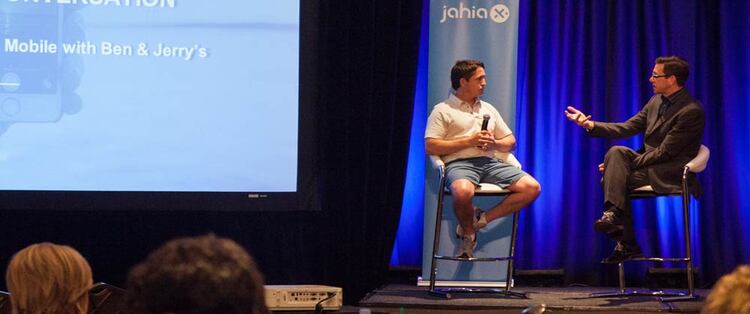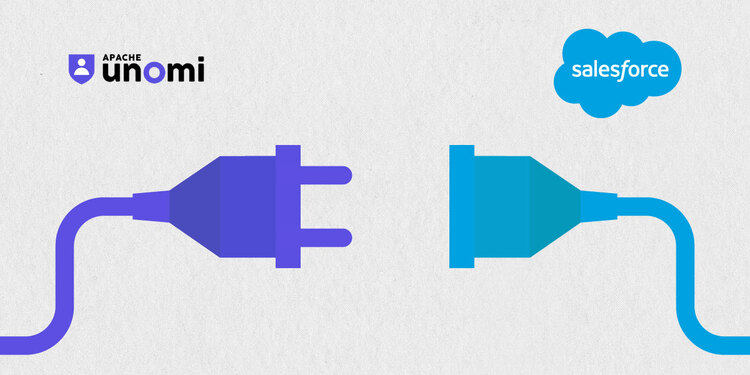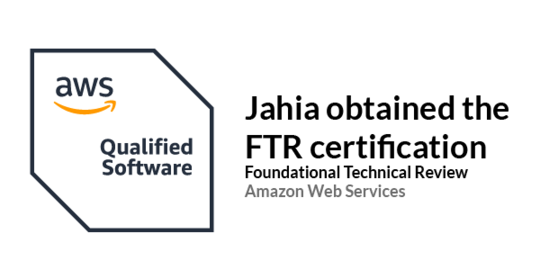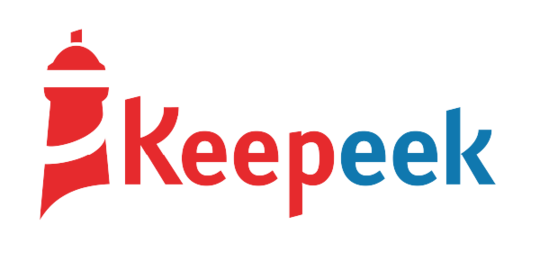The Race Is On: Day Two at JahiaX

We live in the age of the customer. We live in the age of experience. As a result, we need to do things differently. You must be the disruptor vs. being disrupted.
We are all consumers. When talking about reinventing relationships, particularly when tied to revenue generation, we are talking about connected customer experience at all touchpoints. We at Jahia think about how to drive the convergence of digital marketing and commerce because, together, we can change the game of digital marketing and commerce. The urgency is now or us to band together and take action.
Patrick Ritchie of HomeAway.com shared that the value pitch - and the timing of it -creates connection with immediate benefit for consumer which, in turn, creates higher conversion results. Kevin Cochrane defined that the push / pull of marketing means attracting someone with cool, thematic content, learning who they are, then personalizing the offer, which leads to natural conversion. Attraction marketing is the result of understanding your customer.
The National Governor’s Association (NGA) is the collective voice of the U.S. governors (55 members) but NGA’s customers are their constituents - a global, public audience. Kevin Hastings reported that NGA is invigorating their digital presence, including the launch of their newly responsive site last Friday! Further, he and Kevin Cochrane concluded that NGA must evangelize the citizenry while empowering the governors through a non-partisan, non-profit association. Even more, NGA is experiencing digital disruption by going paperless (a well-established trend for enterprises) as well as by developing a social media presence. Kevin Hastings said that people are finding their tribes online and NGA is committed to serving their ‘tribe’ by amplifying their unique voice.
Digital has promise of connecting us but also divides us. We must relate human-to-human across the digital divide, according to Kevin Cochrane. Kevin Hastings agreed and said that NGA is not driving commerce, nor trying to sell anything other than bipartisan perspective and knowledge. However, NGA IS using jExperience to start steering their audience to their mission-critical content. Beyond that, Kevin Hastings shared that NGA has had gains in traffic, especially from search engines, since working with Jahia and our technology.
There are currently two types of journeys for NGA content consumers: natural segmentation from observed behavior and geographic segmentation for relevant content. Analytics on engagement will drive new visitor learning journeys. Future plans for NGA’s digital properties include putting resource centers, or hubs, online for each state and territory so that users can find everything for that area in one place. And, of course, measuring success tangibly by using analytics to monitor the conversion for mission-critical goals: more eyes on research and deeper engagement strategies. Kevin Hastings requested that Jahia keep sharing fresh ideas on how to use Jahia’s technology to create new possibilities.
Ben & Jerry’s is a Jahia customer; naturally, Kevin Cochrane took advantage of the opportunity of talking with Scott Reed to request a new Jahia flavor of ice cream: Swiss chocolate and French vanilla with Java beans. (Fingers crossed!)
Scott Reed said the focus for Ben & Jerry’s is about going global, opening new markets and using websites as brand beacons. It’s not about selling ice cream on the web (yet) – instead, their digital presence is about teaching people about the Ben & Jerry’s brand and being part of the local community.
Global growth for Ben & Jerry’s starts with establishing a local scoop shop with online presence tied to social responsibility and community conversations. Ben and Jerry started the company with an emphasis on product quality and giving back to the community; those values still hold today.
Scott shared that it’s harder to differentiate yourself as a business today. You must stay authentic and focus on the long-term relationships with local communities. One of their ‘secrets’ is to ‘insource’ partners rather than outsource business functionalities.
When asked about working with Jahia, Scott said that it’s not about the technology; instead, it’s about the relationship and Jahia’s ability to see and share their vision. Ben & Jerry’s is committed to constantly learning. Their focus is about getting deeper engagement with people. It’s about using ice cream as a starter for bigger conversations.
It might be surprising to learn that Ben & Jerry’s ‘fails all the time’. This is another nugget that undergirds their success. Kevin Cochrane agreed by saying that the only way to succeed is to fail forward faster. Start and course correct. Experiment and go from there.
Another key to success is ‘Jahia understanding us and helping us see new ways to use technology to really connect with people’. By using jExperience’s deep insights capability, Ben & Jerry’s has the data to help get into micro-audiences. Collaboration and campaign planning are guiding principles of Ben & Jerry’s approach to business.
Further, Kevin Cochrane summed up his thoughts as: Ben & Jerry’s is about authentic voice, engaging and educating employees on topical issues, telling a story and narrative to the market with relevance to the consumer - good business is a by-product.
A special announcement was made - Jahia is sponsoring an Indy 500 race car and driver! EJ Falk from Hippino shared that this sponsorship is an opportunity to raise brand awareness in a dynamic, committed community. There is a clear metaphor between racing and digital enterprise in that both use real-time analytics, 1:1 engagement on mobile devices (Indy pioneered targeting and personalization with push notifications) and being first to the line / market is key.
Kevin Cochrane observed that brands are starting to transform to not just point to products but to lifestyle choices. EJ shared that user experience creates business. At that point, the attendee experience got even more exciting with the introduction of the car driver, Oriol Servia. He shared that, when driving, you are going 230 mph with 132 cars for 3.5 hours with 7-8 pit stops with your heart rate at around 170 - and everything is continuously monitored. One of the things he likes about racing is that it’s black and white - you do it, figure out what you did, make refinements and then go again in two weeks. There is a finite process with a definable finish.
“Fail fast, fail often. Learn to optimize as you go. Sprint every 2 weeks to upgrade and enhance. Teamwork. Everyone all in. Immovable deadlines. Test, tune, optimize, learn, move forward. It’s about what you’re doing next. It’s a lot like racing.” ~ Kevin Cochrane
The Indy 500 is the experience of a lifetime. And now Jahia is part of it.
The afternoon sessions kicked off with Serge Huber talking about the problems of privacy and security related to user tracking. In his session, he showed how jExperience and Apache Unomi can help get back in control of data privacy and security. Finally, he concluded by performing a live demonstration of an integration between a native mobile application that performs indoor positioning using beacons and Apache Unomi. This example demonstrated an example of a use case of a brick-and-mortar to online digital transformation by allowing customers of a retail shop to continue their purchasing experience online in a smooth transition. All the tracking and personalization is performed by Apache Unomi - a central part of jExperience - effectively guaranteeing real control of privacy management.
The next technical session was again presented by Serge about the upcoming changes in Jahia DXP and, basically, the replacement of the Apache Felix OSGi framework with Apache Karaf. The two main new benefits are a much more powerful command line shell and Karaf Features, that make complex OSGi application provisioning a lot better. Customers can now easily package up collection of bundles and even deploy them as a single application across a cluster.
On a roll, Serge then gave his last session of the day introducing a new tool called The Jahia Log Analyzer. This utility allows pluggable and powerful parsing of log files and thread dump files to perform advanced analysis such as recognizing the time of stack traces present in exceptions or stack traces. Once the logs are analyzed the results are pushed into ElasticSearch, where Kibana can be used to perform complex data visualizations. At the end of this session, Serge ran to catch his plane - please know that he is available at shuber at jahia dot com for any additional questions OR if you want to get early access to this tool.
Javier Calvino Lopez of the European Parliament shared the history of their successful intranet migration over the course of nine months (9/14 - 6/15). The site is published in three languages (French, English, German) with more than 20,000 documents in 24 official languages. Some of the challenges of the migration to move from Jahia 5.0.7 to Jahia 7 included (and not limited to): a short deadline for completion, keeping two systems running in parallel, new technology (OSGI) and new VMs in RHEL 7. As a result of the migration, weekly down time went from 1% to just .001%. Other benefits include: improved performance, stable migration, no more down time, hot deployments (no service interruption), new editing interface that is more intuitive and very positive feedback from content editors. Even more, the unique website visits went from 15k in 2015 to 18k in 2016 with a 30% increase in downloaded documents!
iubenda CEO, Andrea Giannangelo, shared about the need for automated privacy and cookie policy for websites. Privacy and cookie policies are mandatory for sites and apps anywhere in the world. iubenda is the simplest way to generate a privacy and cookie policy or to comply with the EU cookie law, with a range of solutions that make online compliance effortless. Jahia’s customers will benefit from iubenda’s online services directly within Jahia’s flagship platform, Jahia DXP, allowing customers to manage privacy policies and assure transparency for each client.
According to Elie Auvray, we are in the golden age of consumer insights; with the plethora of data available, it is up to enterprises to be responsible for that data and to their customers to become trusted by design. Consumers expect immediacy, convenience, and value – or they will go elsewhere. Marketers and businesses are collecting more information about consumers than ever – customers know it and they expect you to use it to make their lives easier, simpler and to help solve their problems. Too often, marketers today are unable to get a clear view of their customers and cannot see the whole picture of who they are and what they need in the moment. By streamlining the data collection process and making it transparent, enterprises can become trusted by design. The major benefit of that is brand longevity through sustainable, authentic relationships.
The Form Factory presentation, by Cédric Mailleux, showed our Partners how they can extend Form Factory V2 in a much easier way than in V1. In version 2, integrators have the opportunity to totally revamp the rendering of their forms by providing themes (themes are a set of views sharing the same name). This allows them to use other styling frameworks than the default Bootstrap 3 rendering, demonstrated by an example that used Angular Material framework, as well as explaining the WZD format to declare your extension point (new Input types, Logic or Validation rules or new Actions).
Cédric also demonstrated the usage of pure JS callbacks to handle the submission of forms from Form Factory in other systems like jExperience or Marketo using our Marketo Connector. And then he finished by showing how - by using the new REST API - it is possible for those two tools to allow for easy form-mapping, even for multiple-step forms.
Sajid Momin then presented a session about the power of extensibility of Jahia DX to support new scripting and templating languages. His presentation covered Thymeleaf templating, which allows developers to work with natural language. Natural languages allows processing of the template without a compiler to render the output. A designer can easily open these templates from the file system with a browser. This empowers the designer and UI developer to own these tasks due to ease of development and familiarity which eliminates any hand-offs to a Java developer. This will also lead to cost reduction of the teams since most UI developers are more abundant than Java developers. Another interesting topic was the support of server side JS or Universal Javascript using Java 8 nashorn. With the popularity of node.js, Java response is with a new JS compiler built from the ground up. The session covered how to develop server side scripts to render markup that is delivered to the end user. Additionally, these scripts can be executed on the client side to reduce code manipulation.
The final note of JahiaX DC is the invitation to JahiaX Paris on November 7 - 8, 2016. Our time together in Washington, D.C. has set the stage for what is already promising to be a game-changing user conference in Paris!
Related: Customer Highlight - Al-Monitor


